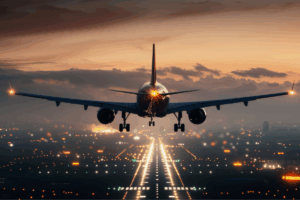Modern aviation infrastructure demands the latest in tech innovations to ensure the safe taking off, taxing, and landing of aircrafts, especially in adverse weather conditions, low visibility, and challenging terrain.
One of these indispensable tools of airport safety is Precision Approach Lighting Systems (PALS). These systems provide pilots with visual cues, aiding them in accurately aligning the aircraft with the runway and executing a precise descent, reducing the likelihood of runway incursions, missed approaches, and accidents.
PALS aren’t luxuries but indispensable necessities along every airstrip to mitigate risks associated with landing an aircraft safely.
What are Precision Approach Lighting Systems?
PALS facilitate safe landings with an array of lighting configurations and visual aids strategically positioned along the approach path and runway. These systems are categorized based on their complexity, with each type tailored to specific airport requirements and operational needs.
The different types of PALS commonly used by airports include:
Basic Approach Lighting System (ALS)
Also known as Simple Approach Lighting Systems (SALS), this is approach lighting in its most fundamental form. It consists of a series of steady lights extending from the runway threshold. ALS provides pilots with crucial visual references during the final stages of approach, enhancing depth perception and aiding in runway alignment.
Medium Intensity Approach Lighting System (MALS)
MALS incorporates additional features on top of ALS technology, such as sequenced flashing lights and runway alignment indicators, augmenting visibility and aiding pilots in precise touchdown assessments.
High-Intensity Approach Lighting System (HIALS)
A step up from MALS, HIALS offers an advanced form of approach lighting. These systems are characterized by their intense illumination and extended visibility range. They often incorporate precision glide slope indicators, enabling pilots to establish a stable descent profile and execute pinpoint landings even in low-visibility conditions.
Precision Approach Path Indicator (PAPI)
One of the more commonly used precision approach lighting systems, PAPI employs a system of lights that indicate whether the aircraft is above, below, or on the correct glide slope for a safe landing, aiding pilots in maintaining the desired approach angle. Visual Approach Slope Indicators (VASI) also operate in a manner similar to PAPI.
Microwave Landing System (MLS)
Microwave landing systems provide exceptional accuracy, especially in complex airspace environments. It integrates radar-based guidance technology with approach lighting, providing precise lateral and vertical guidance to aircrafts during approach and landing.
Many of these Precision Approach Lighting Systems feature dynamic lighting control capabilities, allowing for real-time adjustments to lighting intensity, configuration, and sequencing based on prevailing weather conditions and aircraft parameters, enhancing adaptability and responsiveness under varying operational scenarios.
Advanced PALS are also being increasingly integrated with other navigation and surveillance systems, such as Instrument Landing Systems (ILS) and Global Positioning Systems (GPS), optimizing guidance accuracy and reliability through seamless coordination between different components of the landing infrastructure.
Talk to your airport lighting solution provider for help determining which PAL is best for your particular application.
Additional Benefits Of Using Precision Approach Lighting Systems
Along with helping pilots execute safe descents and landings, this innovative lighting technology offers several additional benefits, including:
Enhanced Situational Awareness
These systems enhance pilots’ situational awareness by improving visibility and spatial orientation during critical phases of flight. By clearly delineating the approach path and runway environment, PALS enables pilots to make informed decisions and allows them to respond promptly to changing conditions.
Increased Airport Operational Efficiency
PALS contribute to increased operational efficiency by minimizing delays and disruptions caused by adverse weather and other undesirable factors affecting aircraft arrivals. These systems help maintain schedule integrity and optimize airspace utilization by facilitating reliable landings in low-visibility conditions.
Instills A Sense Of Confidence In Pilots
Precision Approach Lighting Systems enhance pilot confidence, particularly during challenging landing conditions. These systems empower pilots to execute landings with precision and certainty, irrespective of environmental factors, by providing reliable visual references and guidance under virtually any circumstances.
Reduced Landing Minima
With this advanced technology, airports can establish lower minimum visibility and ceiling requirements for landing operations, enhancing operational flexibility and enabling aircrafts to land safely in conditions that would otherwise necessitate diversion or delay.
As aviation technology develops, PALS will continue to serve the needs of pilots and airports in more advanced ways. For example, emerging technologies such as augmented reality (AR) have the potential to revolutionize PALS by overlaying digital visualizations onto the pilot’s field of view. AR-based PALS can also provide intuitive guidance cues and situational awareness enhancements, giving pilots additional tools and resources to navigate safely through the skies and land aircrafts with precision and confidence.
If you have any questions about PALS, get in touch with Airport Lighting Company today. We’re here to help connect you with a reliable, high-tech solution that will enhance the safety and efficiency of your operation.
Read More: The Evolution Of Technology In Airport Runway Lighting
Call Airport Lighting Company For The Latest In Airport Lighting Technology
The Airport Lighting Company team is standing by to answer your questions about how our tech-based products can help improve the safety, reliability, and efficiency of your runways. Call 315-682-6460 for fast, friendly service you can count on.


